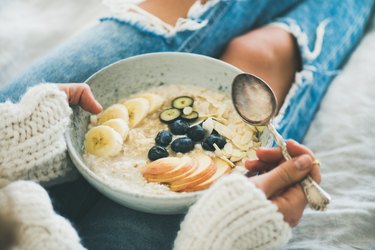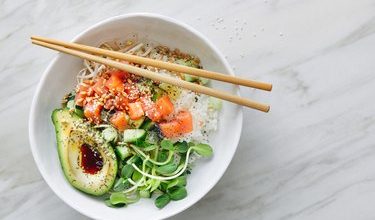Oatmeal Can Help You Lose Weight — but Don’t Make These 3 Mistakes

Foxys_forest_manufacture/iStock/GettyImages
Trendy diets like keto and paleo have made some of our favorite foods, like oats, a no-go — and as a dietitian, I’m just not down with that.
Weight-loss diets often shun oatmeal for it’s “too-high” carb content, when in reality, oats are nutrient-dense and a healthy source of complex carbohydrates.
Video of the Day
Video of the Day
Here’s why oatmeal should be part of your weight-loss plan and how to make it work for you.
There’s So Much to Love About Oatmeal
Look at all oatmeal has to offer. A cup of cooked oats has just 165 calories, along with 28 grams of carbs, 4 grams of fiber, 6 grams of protein and a handful of nutrients like iron, magnesium, zinc, phosphorus, manganese and selenium, according to MyFoodData. In other words, a serving has as much protein as an egg but with more than 15 percent of your fiber needs for the day.
Oatmeal is so special that it has its very own antioxidant called avenanthramides (OK, it may also exist in carnations, but we won’t be filling up on those anytime soon), which also acts as an anti-inflammatory, according to a December 2017 paper in Oxidative Medicine and Cellular Longevity.
It turns out oatmeal-eaters tend to have better diets overall, according to a December 2015 study in Nutrition Research. Specifically, on average, oatmeal-eaters eat get more protein, fiber, vitamin A, thiamin, calcium, phosphorus, magnesium, iron, copper, selenium and potassium than those who shun it.
What the Science Says About Oats and Weight
Nixing oatmeal (and other whole grains for that matter) from weight-loss diets is counterproductive. Not only do they not cause you to gain weight, but they can also actually help you maintain or lose weight.
Here’s what the science says about oats in particular:
May help you eat less: The researchers behind a August 2015 study in the Journal of the American College of Nutrition compared the effects of instant oatmeal versus an oat-based cold cereal. They found that because of the beta-glucan (a type of fiber) in oatmeal, participants had an increase in fullness along with reduced hunger and desire to eat. The oatmeal group also ate less at the following meal.
Could suppress appetite: An August 2018 clinical trial in Appetite builds on current research indicating that beta-glucan suppresses appetite and increases satiety. Researchers in the study compared the effects of two breakfasts, one with and one without beta-glucan. The beta-glucan group experienced greater feelings of fullness and satiety post-meal.
Might support a healthy metabolism: Preliminary research in the American Journal of Clinical Nutrition in March 2017 suggests whole grains — a group that proudly includes oatmeal — may give a modest boost to your boost to your metabolism. The researchers, however, recommend caution when interpreting the results because of dietary adherence issues with the study.
Avoid These 3 Common Mistakes
1. The Mistake: Choosing Oatmeal With Added Sugar
Peaches and cream. Maple and brown sugar. Remember those instant oat packs from your childhood? Whether they conjure up pleasant memories or not, their added sugar content is not so pleasant. One serving can have upwards of 12 grams.
The trouble with added sugar is that we need to look for ways to cut it out of our diet, not add or keep it in. Americans currently eat 77 grams of added sugar per day, according to the American Heart Association. That’s more than three times the daily recommended limit!
The fix: Instead, choose unflavored oatmeal and add your own flavor from fresh fruits, nut butter, chopped nuts, dried fruit and/or cinnamon. By adding things like nut butter, flax or chia seeds, you are also getting more protein to help you feel full.
2. The Mistake: Going Overboard With Portion Size
Too much of anything can be unhealthy — oatmeal included. Oatmeal can be tricky, too, because the portion sizes differ when you’re working with dry oats.
The fix: If you’re making oatmeal from scratch, a serving of dry steel cut oats is one-quarter cup, while a serving of rolled or old-fashioned oats is a half-cup.
It’s easier when you’re working with cooked oatmeal — a serving is always one cup.
3. The Mistake: Not Adding to Your Oatmeal to Make It a Full Meal
OK, yes, we just built the defense on why oatmeal is such a healthy food — but to make it a balanced meal, you’ll want to consider rounding it out a bit. What do we suggest? Well, oats are a good source of complex carbohydrates, so increasing the protein and fat is an excellent place to start.
The fix: Try adding chia seeds, nut butter or even an egg — yes, savory oatmeal is delish! You can also use milk or a plant-based milk with protein — like flaxseed, soy or pea protein — to make the oats instead of just water.
Here’s some recipes to try:
- Dirty Chai Latte Oatmeal by Love & Zest
- Savory Oatmeal with egg and avocado from Eating Bird Food
- Slow Cooker Blueberry Muffin Oats from Dishing Out Health




